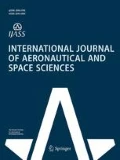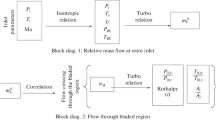Abstract
This paper presents the effects of airflow bleed from the rotor shroud surface between leading and trailing edges on aerodynamic and structural performances of a single-stage transonic axial compressor, NASA stage 37, using three-dimensional Reynolds-averaged Navier–Stokes equations with the k–ε turbulence model. A small airflow mass flow rate is bleed throughout a rotor-bleeding ejector which designed by seven parameters: bleeding angle (°) and ejection angles (°), ejection depth (D), bleeding thickness (H), bleeding position from rotor leading edge (L) in flow direction, bleeding ejection curvature (R), and bleeding width contacted on rotor shroud surface (W). The numerical results for aerodynamic performance: total pressure ratio, adiabatic efficiency, and stall margin of a transonic axial compressor were validated with a smooth casing experimental data. A parametric study of seven design parameters of rotor-bleeding ejector above combined with a small ejection mass flow rate in a single-stage transonic axial compressor for aerodynamic and structural performances was performed. The numerical results show that all aerodynamic performance increases with bleeding airflow from rotor shroud surface, the total deformation on rotor tip leading edge in spanwise direction reduces with a very small increasing in Von-Mises stress in a reference-bleeding airflow as compared to the results of smooth casing.










Similar content being viewed by others

Abbreviations
- C :
-
Chord length of blade tip (mm)
- D :
-
Depth of rotor-bleeding ejector at ejection port (mm)
- H :
-
Bleeding thickness of mechanical support (mm)
- L :
-
Distance from rotor-bleeding ejector and rotor leading edge (mm)
- R :
-
Bleeding radii curvature of rotor-bleeding ejector (mm)
- \( \dot{m} \) :
-
Mass flow rate (kg/s)
- \( \dot{m}_{\text{B}} \) :
-
Mass flow rate of rotor-bleeding ejector at ejection port (kg/s)
- \( \dot{m}_{\text{max} } \) :
-
Mass flow rate at choking condition (kg/s)
- \( \dot{m}_{\text{peak}} \) :
-
Mass flow rate at peak efficiency condition (kg/s)
- \( \dot{m}_{\text{stall}} \) :
-
Mass flow rate at near-stall condition (kg/s)
- \( \dot{m}_{\text{SC}} \) :
-
Mass flow rate at choking condition of smooth casing (kg/s)
- \( P_{\text{t}} \) :
-
Total pressure (Pa)
- \( {\text{PR}}_{\text{peak}} \) :
-
Total pressure ratio at peak adiabatic efficiency condition (Pa)
- \( {\text{PR}}_{\text{stall}} \) :
-
Total pressure ratio at near-stall condition (Pa)
- \( T_{\text{t}} \) :
-
Total temperature (°C)
- W :
-
Bleeding width (mm)
- α :
-
Coverage angle of rotor-bleeding ejector (°)
- β :
-
Ejection angle of rotor-bleeding ejector (°)
- γ:
-
Specific heat ratio
- η :
-
Adiabatic efficiency (%)
- CFD:
-
Computational fluid dynamics
- EFF:
-
Adiabatic efficiency (%)
- PR:
-
Total pressure ratio
- RANS:
-
Reynolds-averaged Navier–Stokes
- SC:
-
Smooth casing
- SM:
-
Stall margin (%)
- SRE:
-
Stable range extension (%)
- max:
-
Choking mass flow point
- peak:
-
Peak adiabatic efficiency point
- stall:
-
Near-stall point
- bleeding:
-
Air-bleeding case
- in:
-
Inlet
- out:
-
Outlet
References
Andrew JY, Ronald JR (1992) Effects of bleed air extraction on thrust level of the F404-GE-400 turbofan engine. NASA TM-104247, the AIAA 28th joint propulsion conference, Nashville, Tennessee
Hathaway MD (2002) Self-recirculating casing treatment concept for enhanced compressor performance. In: Proceedings of the ASME turbo expo 2002, Amsterdam, Netherlands, GT2002-30368
Wellborn SR, Michael LK (2002) Bleed flow interactions with an axial-flow compressor power-stream. In: 38th AIAA/ASME/SAE/ASEE joint propulsion conference and exhibit, Indianapolis, Indiana, USA, AIAA Paper 2002-4057
Ress RA, Carmel J., Hansen JL (2002) Compressor endwall bleed system. U.S. Patent 6,428,271 B1
Gomes RA, Schwarz C, Pfitzner M (2006) Experimental investigation of a generic compressor bleed system. In: Proceedings of the ASME Turbo Expo 2006, Barcelona, Spain, GT2006-90458
Leishman BA, Cumpsty NA (2007) Mechanism of the interaction of a ramped bleed slot with the primary flow. J Turbomach 129:669–678
Ponick S, Kozulovic D, Radespiel R, Becker B, V (2011) Numerical and experimental investigations of a compressor cascade flow with secondary air removal. In: Proceedings of the ASME Turbo Expo 2011, Vancouver, British Columbia, Canada, GT2011-45202
Peltier V, Dullenkopf K, Bauer HJ (2012) Experimental investigation of the performance of different bleed air system designs. In: Proceedings of the ASME Turbo Expo 2012, Copenhagen, Denmark, GT2012-68242
Zhao B, Li SB, Li QS, Zhou S (2011) The impact of bleeding on compressor stator corner separation. ASME Paper, AJK2011-22001, pp 531–537
Cui J, Zhao B, Liu YW, Li SB (2013) Numerical research on the safety and performance of transonic compressor with bleed air at multiple operation state. In: 3rd international symposium on aircraft airworthiness, ISAA 2013, Procedia Engineering 80(2014):352–364
Grimsha SD, Pullan G, Walker T (2015) Bleed-induced distortion in axial compressors. J Turbomach 137(101009):1–9
Dinh CT, Kim KY (2016) Effect of air bleeding on aerodynamic performance of a single-stage axial compressor. Domestic Conference of Koean society for Fluid Machinery, Yeosu, Korea
Lerche AH, Moore JJ, White NM, Hardin J (2012) Dynamic stress prediction in centrifugal compressor blades using fluid structure interaction. In: Proceedings of ASME TURBO EXPO 2012, GT2012-69933, Copenhagen, Denmark
Wang ZK, Tsai GC, Chen YB (2014) One-way fluid-structure interaction simulation of an offshore wind turbine. Int J Eng Technol Innov 4(3):127–137
Chen J, Wang Q, Shen WZ, Pang X, Li S, Guo X (2013) Structural optimization study of composite wind turbine blade. Mater Des 46:247–255
Song YJ, Kang HS, Kim YJ (2015) Reliability evaluation of an axial compressor rotor using fluid-structural interaction analysis. In: 3rd international conference on materials and reliability, Jeju, Korea
Kang HS, Kim YJ (2016) Optimal design of impeller for centrifugal compressor under the influence of one-way fluid-structure-interaction. J Mech Sci Technol 30(9):3953–3959
Reid L, Moore RD (1978) Design and overall performance of four highly loaded, high-speed inlet stages for an advanced high-pressure-ratio core compressor. NASA Technical Paper 1337, Lewis Research Center, National Aeronautics and Space Administration, Cleveland, Ohio 44135
Dinh CT, Ma SB, Kim KY (2017) Effects of a circumferential feed-back channel on aerodynamic performance of a single-stage transonic axial compressor. In: Proceedings ASME Turbo Expo 2017: turbomachinery technical conference and exposition, GT2017-63536 (2017), Charlotte, NC USA
Dinh CT, Ma SB, Kim KY (2017) Aerodynamic optimization of a single-stage axial compressor with stator shroud air injection. AIAA J 55(8):2739–2754
ANSYS CFX-15.0.0 (2013) ANSYS CFX-Solver Theory Guide. ANSYS Inc.
Weiler W (1981) Production of aircraft engine compressor rotor discs with desired service life in titanium alloys. U.S. Patent, 4273512
Ermatchenko AG, Kashaev RM (2011) Production of aircraft engine compressor rotor discs with desired service life in titanium alloys. Mater Phys Mech 11:118–125
Linden DH (2001) Corrosion control in industrial axial flow compressor. In: Proceeding of the 30th turbomachinery symposium, Texas A&M University. Turbomachinery Laboratories, pp 115–120
Aziaka DS, Osigwe EO, Lebele-Alawa BT (2014) Structural and conceptual design analysis of an axial compressor for a 100 MW industrial gas turbine. World J Mech 4:332–347
Chen CJ, Jaw SY (1998) Fundamentals of turbulence modeling. Taylor & Francis, Washington, DC
Thakur R, Gropp W, Toonen B (2005) Optimizing the synchronization operations in message passing interface one-sided communication. Int J High Perform Comput Appl 19:119–128
Acknowledgements
This work is supported by the Vietnam National Foundation for Science and Technology Development under Grant no. 107.03-2018.20 and Vietnamese Government under Grant no. DTDL. CN-54/16.
Author information
Authors and Affiliations
Corresponding author
Additional information
Publisher's Note
Springer Nature remains neutral with regard to jurisdictional claims in published maps and institutional affiliations.
Rights and permissions
About this article
Cite this article
Dinh, CT., Vu, DQ. & Kim, KY. Effects of Rotor-Bleeding Airflow on Aerodynamic and Structural Performances of a Single-Stage Transonic Axial Compressor. Int. J. Aeronaut. Space Sci. 21, 599–611 (2020). https://doi.org/10.1007/s42405-019-00239-5
Received:
Revised:
Accepted:
Published:
Issue Date:
DOI: https://doi.org/10.1007/s42405-019-00239-5



